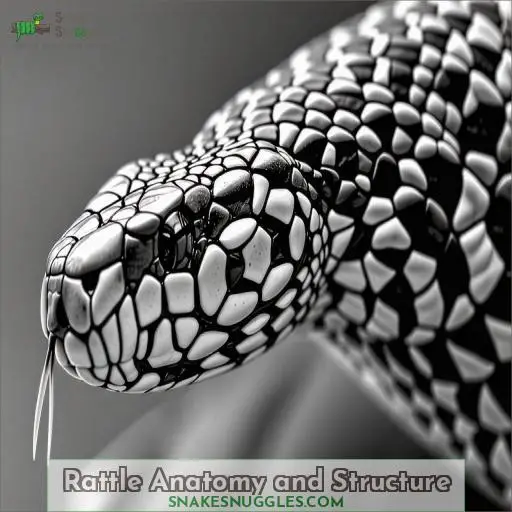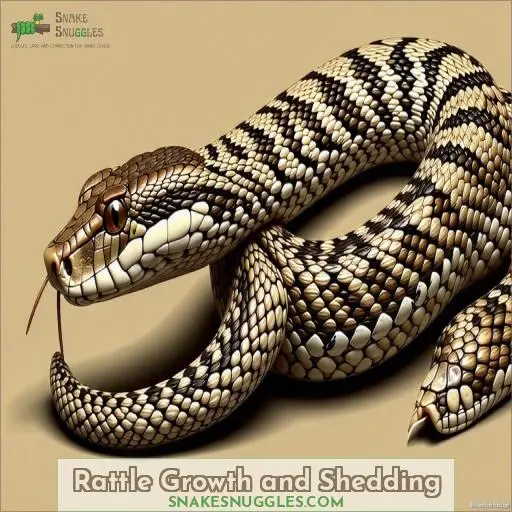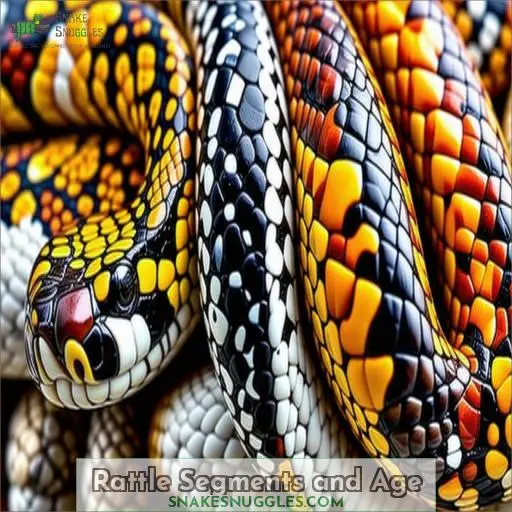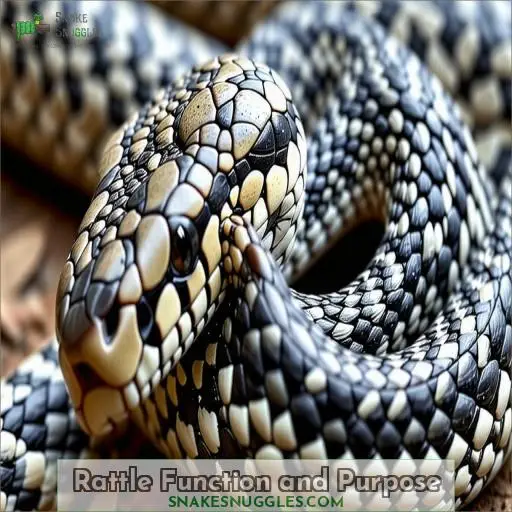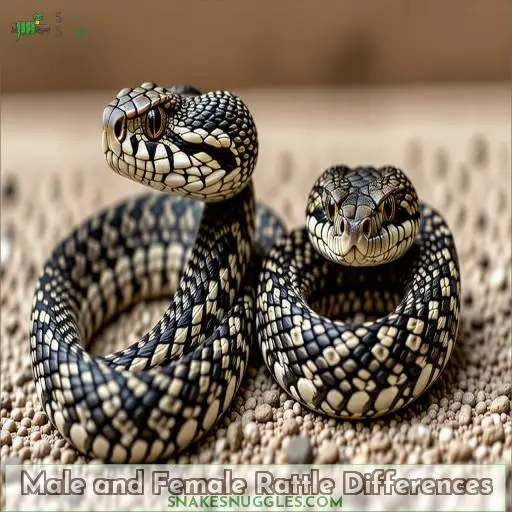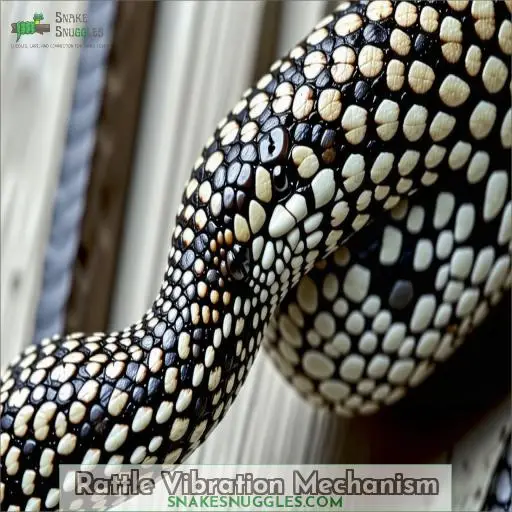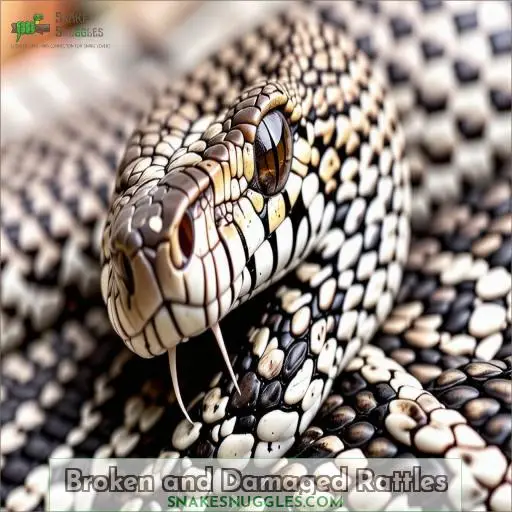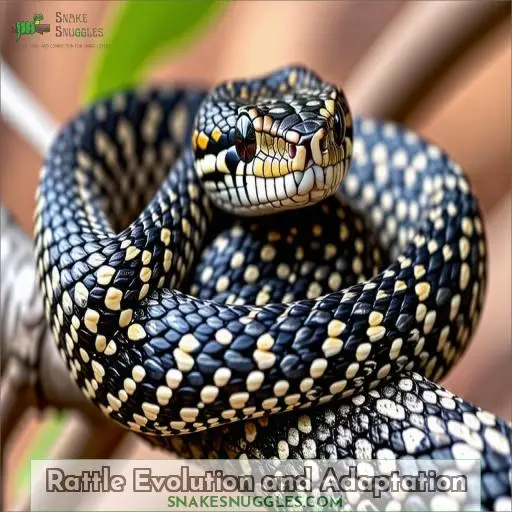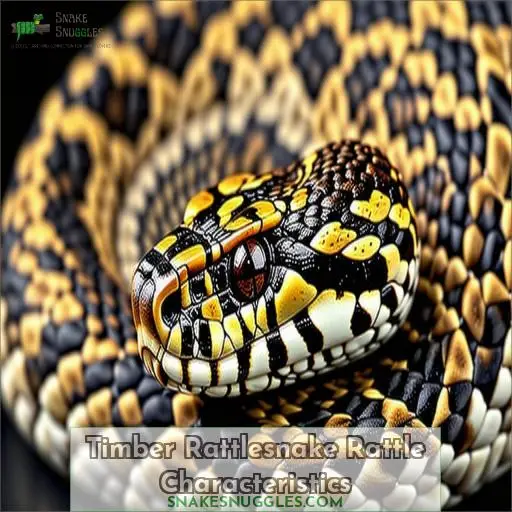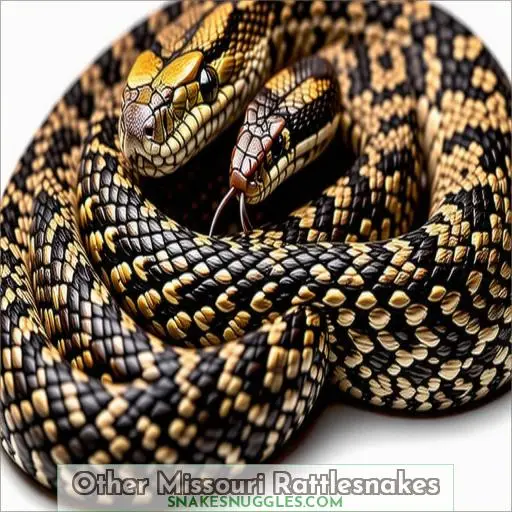This site is supported by our readers. We may earn a commission, at no cost to you, if you purchase through links.
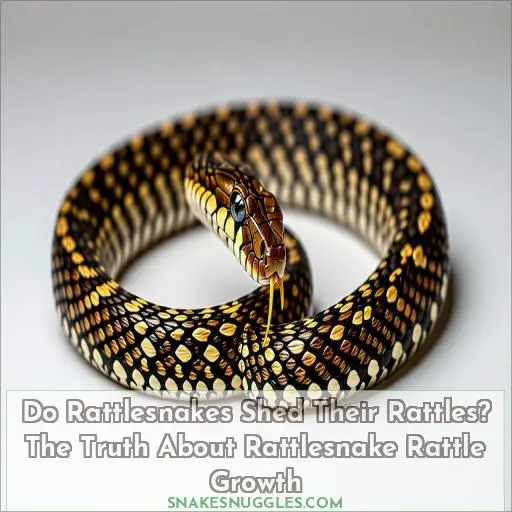 No, rattlesnakes don’t shed their rattles.
No, rattlesnakes don’t shed their rattles.
When a rattlesnake sheds its skin, a new rattle segment forms, allowing its iconic buzz to grow louder with each molt.
The rattle is composed of hollow, interlocked keratin segments that vibrate when the tail muscles contract.
With age, the rattle gradually gains segments, though its size can vary across species and regions.
So if you hear that unmistakable sound, it’s best to give the rattler a wide berth – it’s just trying to avoid a painful encounter for you both.
Want to discover more about this evolutionary marvel’s adaptation?
Table Of Contents
- Key Takeaways
- Do Rattlesnakes Shed Their Rattles?
- Rattle Anatomy and Structure
- Rattle Growth and Shedding
- Rattle Segments and Age
- Rattle Function and Purpose
- Male and Female Rattle Differences
- Rattle Vibration Mechanism
- Broken and Damaged Rattles
- Rattle Evolution and Adaptation
- Timber Rattlesnake Rattle Characteristics
- Other Missouri Rattlesnakes
- Frequently Asked Questions (FAQs)
- How often do rattlesnakes shed their rattles?
- Why are rattlesnakes losing their rattles?
- Do rattlesnake rattles grow back?
- How old is a rattlesnake with 15 rattles?
- Do rattlesnakes intentionally break off their own rattles?
- Can rattlesnakes regrow a rattle after its completely lost?
- Are rattlesnakes born with a full-sized rattle?
- Do rattlesnakes have any control over their rattle volume?
- Can a rattlesnakes rattle be removed to prevent rattling?
- Conclusion
Key Takeaways
- Rattlesnakes do not shed their rattles. Instead, a new rattle segment forms with each skin shed, allowing the rattle to grow louder over time.
- The rattle is composed of hollow, interlocked keratin segments that vibrate when the snake’s tail muscles contract, producing the distinctive buzzing sound.
- Broken or damaged rattle segments are common due to injury, predation attempts, or insect damage, but the rattle grows back with each subsequent skin shed.
- The rattle evolved as a warning device to scare off predators and conserve the snake’s venom and energy, benefiting both the rattlesnake and other animals by promoting safe coexistence.
Do Rattlesnakes Shed Their Rattles?
Yes, rattlesnakes shed their rattles. With each skin shed, a new rattle segment is added to the existing rattle, causing it to grow longer over time.
Rattle Anatomy and Structure
The anatomy of a rattlesnake’s rattle is quite fascinating – it consists of hollow, interlocked keratin segments that vibrate rapidly when the snake contracts its tail muscles, producing the distinctive buzzing sound. Notably, different rattlesnake species possess rattles of varying sizes and tones, with some generating a louder, higher-pitched buzz compared to others.
Composed of Hollow, Interlocked Keratin Segments
A rattlesnake’s rattle is composed of hollow, interlocked keratin scales that vibrate to create its iconic sound. This unique structure evolved to warn off predators and conserve the snake’s venom. The rattle grows with each shed, but broken segments are common.
Vibrates When Tail Muscles Contract
The rattlesnake’s rattle vibrates when its tail muscles contract, creating a distinctive warning sound. The frequency, pitch, duration, and rhythm of the rattle vary based on the snake’s size, mood, and species. This unique adaptation helps protect the rattlesnake and alert potential threats .
Different Species Have Varying Rattle Sizes and Sounds
Rattlesnake rattles vary in size and sound among species, showcasing a remarkable diversity. Geographical variation and evolutionary adaptations contribute to the rattle variation and sound differences. Each species’ unique characteristics help in distinguishing them, reflecting their distinctive evolutionary and ecological paths.
- Geographical variation in rattle characteristics
- Evolutionary adaptations leading to diverse rattle sounds
- Species diversity in rattlesnake rattle features
Rattle Growth and Shedding
You’ll notice that rattlesnakes add a new rattle segment with each skin shed, shedding more frequently when younger—around 3-4 times per year during warm months. As juveniles, their faster shedding rate leads to quicker rattle growth initially.
New Segment Added With Each Skin Shed
Each time a rattlesnake sheds its skin, a new rattle segment forms at the base of its tail. The size of this segment depends on the species, with larger snakes producing louder rattles. However, segments can break off over time, altering the sound.
Faster Shedding in Younger Snakes
Younger rattlesnakes shed their skin more frequently, adding a new rattle segment with each molt. Rapid growth in youth requires:
- Shedding every few weeks
- Gaining multiple rattles annually
- Reaching adult size in 3-5 years
- Slowing to 1-2 sheds per year
Sheds 3-4 Times a Year in Warm Months
During warm months, rattlesnakes shed 3-4 times, contributing to rapid rattle growth . This shedding frequency is particularly accelerated in younger snakes . The newborn rattlesnakes have no rattle initially but start gaining segments with each shed, which doesn’t determine their age . The shedding process facilitates the constant development of their rattle anatomy.
| Shedding Frequency | Rattle Growth in Warm Months | Newborn Rattlesnake Rattles |
|---|---|---|
| 3-4 times a year | Contributes to rapid growth | Initially no rattle |
Rattle Segments and Age
You can’t determine a rattlesnake’s age by counting its rattle segments. Newborn rattlesnakes have no rattle at all; they gain their first rattle segment after shedding their skin for the first time.
Cannot Determine Age by Number of Rattles
Rattlesnakes shed their skin and add a new rattle segment each time, but the number of rattles doesn’t accurately indicate age. Shedding frequency slows as snakes mature, and rattle variation exists between species. Estimating age from rattles is unreliable (Source).
Newborn Rattlesnakes Have No Rattle
Newborn rattlesnakes enter the world without rattles, their tails smooth and unadorned. These young snakes must wait patiently for their first skin shed before gaining their inaugural rattle segment, a milestone in their growth and development .
First Rattle Segment Added After First Skin Shed
After their first skin shed, rattlesnakes acquire their first rattle segment. This initial segment marks the beginning of their unique rattles, which play a significant role in their defense mechanisms. The growth, color, and shape of the rattle develop gradually with each shedding, forming a distinctive and functional attribute of the rattlesnake.
Rattle Function and Purpose
The rattlesnake’s iconic rattle serves essential purposes: it frightens potential predators, warning them to keep their distance, and alerts other creatures to steer clear, preventing the snake from wasting its precious venom or suffering injury. This mutually beneficial adaptation allows both the rattlesnake and other animals to avoid harmful encounters safely.
Scares Off Predators
The rattle’s sharp buzz warns predators of the snake’s venomous bite, deterring attacks and conserving the snake’s venom for hunting prey .
Warns Other Creatures to Stay Away
The rattlesnake’s rattle is critical for warning other creatures to stay away, aiding in predator avoidance, and ensuring animal safety, contributing to the preservation of venom and the evolution of rattlesnakes .
- Guarantees animal safety
- Contributes to the conservation of venom
- Facilitates the evolution of rattlesnakes
Protects Rattlesnake From Venom Waste or Injury
The rattle protects rattlesnakes from venom waste and injury, conserving precious venom for hunting and defense. Damaged rattles can be shed to prevent further harm .
| Rattle Damage | Venom Waste | Injury Protection | Rattle Longevity |
|---|---|---|---|
| Broken segments | Venom loss | Prevents further harm | Shed damaged rattles |
| Insect damage | Conserves venom | Protects from predators | Rattles last longer |
| Wear and tear | Venom used efficiently | Avoids unnecessary injury | Rattles remain functional |
| Trauma | Venom saved for hunting | Prevents infection | Rattles stay intact |
Benefits Both Rattlesnake and Other Animals
The rattlesnake’s rattle benefits both the snake and other creatures by warning of danger, conserving venom, and promoting coexistence in the ecosystem .
- Warns predators and prey of the snake’s presence, preventing unnecessary confrontations
- Conserves the snake’s venom and energy for hunting and defense
- Promotes a balanced ecosystem by allowing animals to avoid harm
Allows Animals to Avoid Harm
The rattlesnake’s rattle serves to warn other creatures, giving them the opportunity to avoid harm, benefiting both the rattlesnake and its potential predators.
Male and Female Rattle Differences
You’ll notice a distinct difference in the tails of male and female rattlesnakes. Male rattlesnakes possess thicker, longer tails that taper gradually from the body, while female tails narrow abruptly, resulting in a slimmer appearance.
Males Have Thicker, Longer Tails
Male rattlesnakes have thicker, longer tails compared to females. Their tails are proportionally larger in relation to their overall body size. This difference in tail size is a key distinguishing feature between male and female rattlesnakes like the western diamondback, eastern massasauga, and pygmy rattlesnake.
Male Tails Taper Gradually From Body
Male rattlesnake tails taper gradually from their muscular bodies, allowing them to shake their rattles with greater force and volume. This intimidating display warns potential predators to keep their distance, while the abrupt female tail shape is less conducive for producing loud rattle sounds .
Female Tails Narrow Abruptly
In rattlesnakes, female tails narrow abruptly at the base, unlike male tails that taper gradually.
This gender difference aids in distinguishing between male and female rattlesnakes visually.
Additionally, this characteristic is essential when determining the sex of rattlesnakes without physical contact, particularly in North America.
Female tails uniquely exhibit this narrowing trait, contrasting with the gradual tapering seen in male tails.
Rattle Vibration Mechanism
The rattlesnake’s rattle is formed by hollow, interlocked keratin segments that vibrate when the snake contracts its tail muscles. This muscular contraction creates the iconic rattling sound, which warns predators and other creatures, helping the snake avoid harm while conserving energy and venom.
Contracts Tail Muscles to Vibrate Segments
The rattlesnake contracts its tail muscles to vibrate its segments, creating a distinct rattling sound . This mechanism serves to transmit sound effectively to warn off potential predators and protect the snake from unnecessary confrontation . The specific vibration pattern and frequency of the rattle may vary between rattlesnake species, such as the eastern diamondback, timber, and Mojave green rattlesnakes .
Creates a Rattling Sound
When a rattlesnake contracts its tail muscles, the interlocked keratin segments vibrate, creating the distinctive rattling sound. The frequency and shape of this rattle vary among species. This sound serves as a warning signal, benefiting both the rattlesnake and other wildlife, aiding in wildlife control and promoting safety in environments.
Warns Predators and Other Creatures
The rattle’s vibration warns predators and other creatures to stay away, thanks to its unique shape, color patterns, and sound frequency. This defense mechanism conserves the rattlesnake’s energy and venom while protecting both the snake and its potential prey from harm.
- Rattle shape, color, and patterns create a distinct visual warning
- High-frequency buzzing sound deters predators and alerts prey
- Vibration duration signals the rattlesnake’s level of threat
Broken and Damaged Rattles
Rattlesnakes’ iconic rattles are composed of loosely interlocked, hollow keratin segments that can break or become damaged quite easily. It’s common to find rattlesnakes with broken or missing rattle segments, as injury, predation attempts, or even insects gnawing on the rattle can impair its function and vibration capability.
Broken Segments Are Common
Broken rattlesnake segments are a common issue, affecting rattle durability and strength. With each shed, new segments replace lost ones. Repairing a rattle is important if segments weaken or break off, ensuring adequate function. Vigilance in checking for segment loss can help maintain the rattle’s effectiveness.
Injury or Damage Can Impair Rattle Function
Injury or a run-in with a sharp object can weaken your rattle’s strength, causing segments to break off. While a few broken pieces won’t stop your rattle, extensive damage may impair its function. Protect your rattle to maintain its full rattling power and warn off predators effectively.
Insects Can Weaken Rattle
Insects can weaken a rattlesnake’s rattle, shortening its lifespan. Ants, beetles, and other bugs may burrow into the hollow keratin segments, causing discoloration and damage. Proper rattle maintenance, like regular cleaning and handling with care, helps preserve this iconic warning system.
- Insects bore into rattle segments
- Causes discoloration and weakening
- Proper cleaning and handling helps
- Rattle lifespan depends on maintenance
Rattle Evolution and Adaptation
You’ve learned about the rattlesnake’s rattle anatomy and growth, but have you considered its evolutionary origins? The rattle likely evolved on the Great Plains as a warning device, allowing rattlesnakes to scare off large hooved animals that could trample them while conserving precious venom and energy in the process.
Evolved on Great Plains to Avoid Trampling
The rattlesnake’s rattle evolved on the Great Plains to avoid being trampled by hooved animals, serving as a warning signal and conserving the snake’s energy and venom for hunting and defense .
Sharp Buzz Alerts Hooved Animals
Sharp buzz emitted by rattlesnake rattles alerts hooved animals to potential danger. This evolutionarily developed function aids in preventing unintentional encounters, highlighting the critical role of rattle sound in rattlesnake survival.
- Warns hooved animals to stay away
- Aids in preventing unintentional encounters
- Evolutionarily developed function
Conserves Energy and Venom
By conserving energy and venom**, the rattlesnake’s rattle enhances survival. The loud buzz warns prey, deterring unnecessary strikes and venom use . This adaptation optimizes the snake’s energy expenditure and venom supply for hunting and defense .
Protects From Predators and Intruders
Rattlesnake rattles, made of hollow keratin scales, vibrate to alert predators and intruders. Evolved rattle features, regardless of color, material, length, age, or shape, effectively deter threats and signal potential danger.
Timber Rattlesnake Rattle Characteristics
The timber rattlesnake is a venomous species found in Missouri, so you must exercise extreme caution if you encounter one in south-facing rocky areas, where they often congregate. These nocturnal predators feed primarily on rodents and rabbits, and any bite requires immediate medical attention due to their potent venom.
Venomous and Dangerous
Timber rattlesnakes are venomous and dangerous. Their potent venom can cause severe harm if bitten. Avoid approaching these snakes and give them space .
Bites Require Immediate Medical Attention
Timber rattlesnake bites are venomous and dangerous, necessitating immediate medical attention due to potential venom effects. Treatment may involve antivenom if available, emphasizing snake bite prevention strategies.
Congregates in South-facing Rocky Areas
The timber rattlesnake congregates in south-facing rocky areas due to the favorable habitat, vegetation, and climate. The elevation and prey availability contribute to its choice of habitat (Source).
Nocturnal During Summer
During hot summer months, timber rattlesnakes become nocturnal, seeking refuge in rocky crevices and dens to avoid daytime heat while hunting small rodents at night .
- Nocturnal behavior to escape summer heat
- Seek rocky dens and crevices for daytime refuge
- Hunt small rodents at night
- Avoid daytime activity in hot summer months
Eats Rodents and Rabbits
Timber rattlesnakes primarily eat small rodents like mice and voles, as well as rabbits. Their diet varies by habitat and season.
| Habitat | Diet | Behavior | Reproduction | Physiology |
|---|---|---|---|---|
| Deciduous forests, rocky outcrops | Rodents, rabbits, birds, insects | Nocturnal in summer, ambush predator | Live birth, 5-9 young | Pit viper, heat-sensing pits, venom |
Other Missouri Rattlesnakes
In Missouri, you’ll find two other notable rattlesnake species besides the timber rattlesnake: the western pygmy rattlesnake and the prairie massasauga. These small but venomous snakes are protected in the state, so it’s important to observe them from a safe distance if encountered in the wild.
Western Pygmy
The Western Pygmy rattlesnake, a Missouri species, is known for its habitat preference for pine flatwoods, sandhills, and hardwood forests. These small snakes typically measure 15-22 inches, and they possess a potent venom that can cause significant harm. The conservation status of the Western Pygmy rattlesnake is of concern, as its population is declining due to habitat loss and fragmentation. (Source)
Prairie Massasauga
The prairie massasauga is a small, stout rattlesnake found in Missouri’s prairies and wetlands.
Its range extends from central Missouri to the southwest corner of the state.
This nocturnal snake has a gray or brown coloration with dark blotches.
It feeds on small rodents and amphibians.
The prairie massasauga is a threatened species in Missouri due to habitat loss and fragmentation.
Conservation efforts aim to protect its prairie and wetland habitats.
Frequently Asked Questions (FAQs)
How often do rattlesnakes shed their rattles?
Like a well-oiled machine, rattlesnakes shed their rattles around 3-4 times yearly during warm months, adding new segments with each molt.
Why are rattlesnakes losing their rattles?
There’s no evidence rattlesnakes are losing their rattles. Their rattle evolves for warning, not being lost. They may rattle less around humans, but the rattle serves an important purpose.
Do rattlesnake rattles grow back?
Like the phoenix rising from the ashes, rattlesnake rattles regenerate with each skin shedding, growing a new segment for a louder warning call.
How old is a rattlesnake with 15 rattles?
You can’t tell a rattlesnake’s age by counting its rattles. Some snakes add segments irregularly, and segments often break off.
Do rattlesnakes intentionally break off their own rattles?
As the saying goes, Don’t fix what isn’t broken. No, rattlesnakes don’t intentionally break off their own rattles – it’s a defense mechanism to warn predators.
Can rattlesnakes regrow a rattle after its completely lost?
No, rattlesnakes can’t regrow a lost rattle. The rattle’s segments are added each time the snake sheds its skin. If the rattle breaks off, it’s lost for good. But snakes adapt well and survive without their rattle’s warning signal.
Are rattlesnakes born with a full-sized rattle?
Nope, newborn rattlers lack a full rattle initially. Rattle-less, these babies gain their first button post-shedding – a promising prelude to future, full-fledged rattling repertoires.
Do rattlesnakes have any control over their rattle volume?
Yes, rattlesnakes can modulate their rattle volume by controlling the force and intensity of their tail vibrations. A louder rattle signals greater danger or aggression, allowing them to effectively communicate their threat level.
Can a rattlesnakes rattle be removed to prevent rattling?
Sounding like a buzzing coil, a rattlesnake’s rattle is an integral part of its defense mechanism. You can’t simply remove the rattle, as it grows back with each shed skin.
Conclusion
Truly, the rattlesnake’s iconic buzz is an evolutionary masterpiece.
Whether you encounter the timber rattlesnake’s sharp warning or another species’ distinctive rattle, remember: they don’t shed their rattles, but gain new segments with each molt.
This ingenious adaptation protects both snake and potential victim, allowing all to avoid harm through its unmistakable alert.

